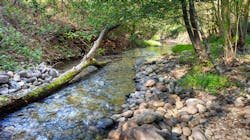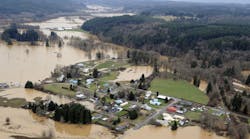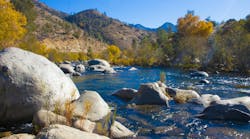California awards $9.2M for stream restoration, flood control
California’s Department of Water Resources announced $9.2 million in grants for five projects that will restore streams and creeks, as well as reduce flood risk, across multiple communities in the state.
The projects are funded by DWR’s Riverine Stewardship Program and Urban Stream Restoration Program, which deliver technical and financial assistance for the protection of listed fish species in combination with flood risk reduction and ecosystem enhancement of urban streams.
“Our communities and wildlife alike are facing multiple challenges posed by climate extremes, including both drought and flooding,” said DWR Director Karla Nemeth. “This funding will help manage future flooding events, and protect watersheds, local wildlife, and aquatic habitat.”
The awarded projects are designed to promote community participation in the planning process, encourage public support for long-term management and increase public awareness of project benefits to the community, the environment, and the sustainability of California’s water resources.
The five projects are situated across Sonoma County, Monterey County, Nevada County, Marin County, and Stanislaus County.
In Sonoma County, the Lower Colgan Creek Restoration Project received $4.3 million to restore 11.27 acres of aquatic habitat along 1.3 miles of creek. The project will prevent flood damage to nearby homes and businesses by widening the creek and reconnecting it with a more natural floodplain. The funding will support the removal of non-native and invasive plants, which will be replaced with native vegetation. The project will also utilize environmental education curriculum and public outreach to engage the community in helping to care for the creek.
In Monterey County, the Carr Lake Restoration project received $2.5 million to convert 67 acres of urban agricultural land into fish and wildlife habitat. The project will enhance fish and wildlife habitat, improve water quality, reduce greenhouse gas emissions and enhance carbon sequestration in creeks and vegetated areas, and offer public access to a large natural area in the center of the largest city in Monterey County with trails, boardwalks, interpretive signs and educational opportunities. The project will also protect surrounding homes above the site location from flood impacts.
In Nevada County, the Donner Creek Restoration project received $1.3 million to restore 6.5 acres at four sites along Donner Creek impacted by urban development located within a disadvantaged community in Truckee. The project will use a watershed approach to reduce flood risk, improve bank stabilization, reduce excess sedimentation, enhance wetlands to treat pollution from urban runoff and install native vegetation to enhance aquatic habitat. The project team will include the local community throughout the process by educating local students about environmental issues, conducting community outreach in an underserved community and providing volunteer opportunities to support restoration.
In Marin County, the Lagunitas Creek Salmonid Spawning Gravel Improvement Project received $590,000 to install 1,700 tons of river gravel for spawning and rearing habitat for salmonids, balance the loss of sediment from upstream dams and improve drought resiliency and water quality. The project will benefit endangered coho salmon, steelhead and freshwater shrimp.
In Stanislaus County, Phase III of the Stanley Wakefield Wilderness Area Salmonid Habitat Restoration Project received $561,243 to restore more than 45 acres of habitat along the lower Stanislaus River to benefit salmonids and other native fish. The project will improve fish migration corridors and habitat to provide food resources and shelter and has the potential to improve salmonid and fish species’ resilience to climate change. The project will improve water quality and habitat, and support groundwater recharge and carbon sequestration.
Urban Streams Restoration Program accepting applications
The Urban Streams Restoration Program will continue accepting applications for project funding on a rolling basis. DWR has a total of $5.4 million in funds available through the program. Eligible applicants include Tribes, local public agencies and certified nonprofits as specified in the program guidelines and proposal solicitation package. Other applicant types such as community groups, will be considered on a case-by-case basis. For-profit corporations, non-public entities and individual landowners are not eligible.
Project proponents can submit concept proposals and grant applications using DWR’s online submittal tool, GRanTS. DWR will identify projects through the grant application process and will match concept proposals to the appropriate funding source based on eligibility. Awards will be made based on how responsive the application is to program priorities and will be made on a rolling basis until all funds are committed.
The guidelines and proposal solicitation package, as well as detailed information on the solicitation rules, procedures and process can be accessed at the Riverine Stewardship Program – Grants webpage.


